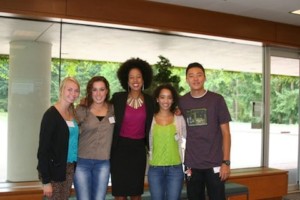Students Are Calling BS on High School and Opportunity Knocks
Key Points
-
Over the last year, a growing number of high school students calling BS on their high school experience.
-
Many students in our area who attended our Iowa BIG program half days were willing to share their feelings about high school post-pandemic.

This is the first of a three-part series on valuing learner time.
The pandemic has and continues to cause ripples across the educational landscape. Over the last year, one such ripple has been a growing number of high school students calling BS on their high school experience. Many students in our area who attended our Iowa BIG program half days were willing to share their feelings about high school post-pandemic. And an interesting pattern emerged. The finding was summed up best by one unabashed student who told us:
“For the last two years I have worked on my school work for 90-120 minutes a day, was successful, and now I’m being asked to give school seven hours a day of my time. Why? They’ve shown me that they’ve been wasting five hours of my time each day. I’ve got more important things to do with my time than give school 20 hours of wasted time each week. Schools talk of valuing its students. How is wasting 20 hours a week of my time valuing me?”
The student went on to share that they were able to work nearly 40 hours a week during the pandemic at $15/hour. He essentially asked why the school was now asking him to forgo $20,000 this school year just to sit in a seat learning what he could have done by 9 am each day.
After visiting with many colleagues across the country, I learned that a similar sentiment exists in many, many schools and communities. The instant defensive reaction by some educators is, “Well, yes, but we had to focus on the core standards and weren’t able to go so deep and, besides, there’s a lot more to the high school experience than the classes.” Okay. And…
Let’s be clear. These students are not wrong. The pandemic showed students that much of what they were required to do and endure during pre-pandemic high school was a lot of busywork and tasks that held little relevance or interest to them, and apparently didn’t really matter since they were able to be successful without all that extra work. When schools lost their ability to command and control a student’s time, it forced a different economy for schools and educators. It required the curriculum to be pared down to only the essential standards and information. It now had a very real and powerful competitor for the student’s time – a job, a hobby, sports, music, sleep… And boring, tedious and/or irrelevant assignments and work can’t, and shouldn’t, win out. It has exposed the gross inefficiencies of the traditional approach to high school education.
Schools talk a lot about personalizing learning, of meeting kids where they are, and yet we see most high schools continue forward with prescribed, discipline-specific courses conducted in roughly 150-hour annual segments. This approach continues to isolate the disciplines from one another despite the fact that they are highly interrelated. De-contextualized content is boring and lacks that “hook” that helps make learning sticky. This system continues to waste student and teacher time in a myriad of ways, including but not limited to:
- Forcing students who are highly engaged and/or competent in the discipline/subject to have to wait for the curriculum to catch up with them
- Creating a large group of students who believe the discipline/subject isn’t for them and conclude that they hate that subject and should work to avoid it
- Transforming intrinsic motivation to learn into an extrinsic game of point and credit chasing and the belief that you can and should eventually “be done” with learning
- Channeling every student through a course that makes the erroneous assumption that every student in every school is going to major in that subject, therefore making it like a watered-down 101 course that disengages the majority of students
- Taking interesting material, or material few people need to know, and making it boring and irrelevant simply to fill the time and to avoid being accused of not being “rigorous.” Don’t get me started on what “rigor” really means but if you’re curious, look up its definition and ask, “Is that really what I want for my classroom and my kids?”
This approach continues to isolate the disciplines from one another despite the fact that they are highly interrelated.
Trace Pickering
Students are no longer a captive audience. They have more options and choices. To avoid obsolescence, perhaps schools should focus on making school a place where kids see value and want to come to each day. There are many schools already doing this – Village High School in Colorado Springs, Purdue Polytechnic High School in Indianapolis, One Stone in Boise, Idaho, Teton Science School in Wyoming, Crosstown High School in Memphis, and programs like Iowa BIG.
This is a wonderful opportunity to put in place the things that really drive 21st-century skills and give students the keys to their own learning and growth. To truly personalize learning for students, and unlock teacher professionalism and creativity in the process. That extra time could allow students to pursue areas of passion and interest, to dive deep into a subject that interests them, pursue job shadows and internships, and earn and learn on a job.
In the next few installments of this blog, we’ll dive deeper into this opportunity and dig into questions like:
- What could you do with 5 additional hours of time with students each day?
- How could the school leverage the student’s $15/hour job to teach them critical 21st-century skills?
- How could the school engage their community to have students tackle problems and bring to life new opportunities for their city?
- How could you help students meet their standards and learning objectives through their own hobbies and interests?
- How could you help students more confidently own their personal learning journey?
- How could a school tailor its in-building learning to ensure that it maximized student learning around student interests and more efficiently helped them learn those skills and disciplines less interesting to them?
- How could a school place ensure all students had a healthy understanding of and respect for the disciplines above the relentless drive to teach standards focused on preparing discipline majors?
- How could you bring joy back to the lives of teachers and students?
- How could you free teachers from constant grading, lesson design, and chasing down students to get them to do the work?







TV
YES! This approach to high school could spark a transformation in education on the whole. Just like District-born policymakers need to listen to schoolside leaders, and school principals and administrators need to listen to their teachers, so too do teachers need to listen to their students. A lot of young people at 15, 16, 17 know what they want or need to succeed; how can we make space for those self-directed folx while also providing structures and supports for those who don't know what they want or how they learn best?